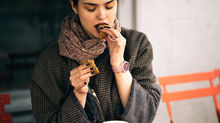Is Your Kitchen Ready For Winter Baking?
- Beth
- Dec 29, 2017
- 3 min read

Well, cold winter weather has arrived (at least in these parts). And to make things worse, soon the holiday season will be over and here we are with our extra pounds, our brand new mixers and no idea how to reconcile the two.
If you're feeling sluggish and under-motivated right about now, you are not alone. According to the National Institute of Mental Health, as many as 20% of Americans suffer from some form of winter blues. The good news is that baking, and the creative process involved with it, can help. This is not the time to shelve the mixing bowls, spatulas and cookie sheets. It's the time to learn how to get bread to rise in cold weather. This is the kind of fun guaranteed to chase away the winter doldrums. So let's get started.
Assess your kitchen
Is your kitchen ready for cold weather baking? Does it matter? Of course it matters. That's why we're bothering to mention it. Preparing your kitchen this time of year involves three main factors:
Humidity: Winter humidity affects results, whether you are baking bread or making cakes. Why? Because ingredients soak up moisture when the air is humid, and dry out when moisture levels are low.
The best way to measure humidity in your kitchen is with a hygrometer. These are easy to use and are not expensive. Once you know your moisture level you can deal with it in two ways: by adjusting the humidity in your kitchen, or by adjusting the recipe. In cold winter climates humidity tends to be lower, so try turning up the thermostat in conjunction with a pot of boiling water on the stove or a room humidifier.
Or, if your humidity is high (above 60%), reduce the amount of liquid in your recipe by 1/8-1/4. If the humidity is low (below 30%), increase liquids by 1/8-1/4,
Temperature: The air temperature in your kitchen affects the way dough rises, Yeast will not activate at temperatures that are not optimal. And, baking and rising times are affected by your kitchen's temp.
If you plan to bake bread this winter, be aware that there is an ideal range of temps for each ingredient, and that they are affected by low air temps. Here's a good winter baking tip: proof your yeast at a slightly higher temp (90 degrees) rather than the standard 80 degrees, and warm the oven before placing your dough in it to rise (but be sure to turn it off before raising!). That way, if your kitchen air temp is lower, the yeast (and dough) will still rise properly.

Supplies: The winter kitchen requires both the tools and pantry staples to ensure effortless success, in spite of the cold weather. We all know that certain items are hard to find fresh this time of year, so have on hand these essential items. Gather and properly store them in advance and you will be ahead of the game:
Frozen berries--red raspberries, blueberries, strawberries, cranberries
Nuts--walnuts, pecans, almonds, macadamia
Fresh flour, baking soda and powder in air-tight containers
Gel food colors, cookie cutters and canned frostings
White and dark chocolate baking bars
Fresh extracts and spices
Non-stick sprays and oils
Unsalted butter
Hand or stand mixer
Get started
Winter is a great time to experiment. After all, holiday baking obligations have been met, there's nobody to impress, and you can start building a whole new repertoire of fabulous baked goods for the New Year, Plus, it will give you some exciting projects to work on while the weather outside is frightful. So get your kitchen ready and get started now. Happy winter baking!
































Comments